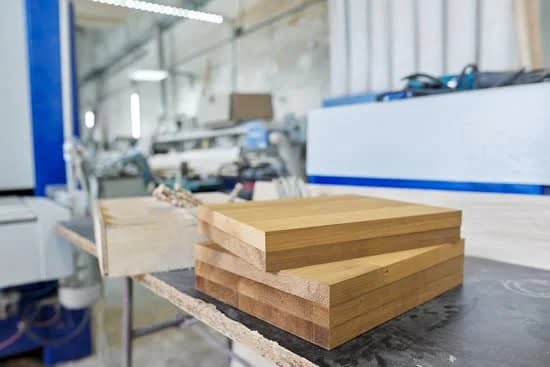Are you a woodworking enthusiast looking for a more efficient way to apply adhesive to your projects? In this article, we will delve into the world of woodworker’s glue bots and explore how they can revolutionize your woodworking endeavors. From understanding what a woodworker’s glue bot is to discussing its importance in woodworking projects, we will cover everything you need to know to incorporate this handy tool into your toolkit.
A woodworker’s glue bot is an essential tool for any woodworking project, offering a convenient and precise method for applying adhesive. Unlike traditional glue bottles or containers, a glue bot provides better control and eliminates the mess often associated with conventional glue application methods. Whether you are working on intricate joinery or bonding large surfaces, mastering the use of a glue bot can significantly streamline your workflow and improve the quality of your craftsmanship.
In the following sections, we will explore the various benefits of using a woodworker’s glue bot over traditional adhesive application methods. Additionally, we will provide insights on how to select the right glue bot for your specific needs and walk you through the process of preparing and using this indispensable tool.
Whether you are new to woodworking or looking to upgrade your techniques, understanding how to use a woodworker’s glue bot is an invaluable skill that can elevate your woodworking projects.
Benefits of Using a Glue Bot
Woodworkers rely on a variety of tools and equipment to bring their woodworking projects to life, and one such essential item is the glue bot. This innovative tool is designed to streamline the adhesive application process and offer several benefits over traditional glue bottles or containers. In this section, we will explore the advantages of using a glue bot in woodworking projects and why it has become a favorite among woodworkers.
One of the primary benefits of using a glue bot is its precise and controlled application. Unlike traditional glue bottles that may dispense excessive adhesive or create messy drips, a glue bot allows for accurate dispensing of the right amount of glue exactly where it’s needed. This level of control is especially crucial when working on intricate joinery or delicate woodworking pieces, as it helps prevent wastage and ensures neat, professional-looking results.
In addition to precise application, a glue bot also offers better ergonomics and ease of use. Many woodworkers appreciate the comfortable grip and smooth dispensing mechanism of a glue bot, making it convenient to use for extended periods without hand fatigue.
The design of a glue bot also minimizes air exposure to the adhesive, reducing the risk of premature drying or clogging-common issues associated with traditional glue bottles. When choosing a woodworker’s glue bot for your workshop, consider factors such as capacity, nozzle design for specific applications, compatibility with different types of adhesives (like wood glues or polyurethane), and ease of cleaning.
| Advantages | Description |
|---|---|
| Precise Application | Avoids wastage by providing accurate dispensing. |
| Better Ergonomics | Comfortable grip reduces hand fatigue during prolonged use. |
| Reduced Air Exposure | Minimizes premature drying or clogging compared to traditional glue bottles. |
Choosing the Right Glue Bot
When it comes to choosing the right glue bot for your woodworking projects, there are a few key factors to consider. With a variety of options available in the market, selecting the best one for your needs can be overwhelming. By understanding the different types of glue bots and their features, you can make an informed decision that will enhance your woodworking experience.
Types of Glue Bots
There are several types of glue bots available, each designed to cater to specific woodworking requirements. Some common types include standard bottle-style glue bots, pressurized glue pots, and precision tip applicators. Standard bottle-style glue bots are suitable for general woodworking tasks and provide easy refilling options. Pressurized glue pots are ideal for professional woodworking applications and ensure continuous adhesive flow without clogging. Precision tip applicators offer precise control and are best suited for intricate woodworking projects.
Features to Consider
When choosing a glue bot, it is essential to consider certain features that are crucial for efficient use. Look for a bot with an ergonomic design that provides a comfortable grip during application. The size of the nozzle or applicator tip is also important, as it determines the precision of adhesive application. Additionally, opt for a glue bot with a transparent body or indicator window, allowing you to monitor the adhesive level and prevent running out during critical tasks.
Selecting the Best Glue Bot for Your Needs
To select the best glue bot for your woodworking needs, assess the type of projects you primarily work on and the level of precision and control required. Consider factors such as adhesive compatibility, capacity, ease of cleaning, and overall durability when making your selection. Reading product reviews from other woodworkers can also provide valuable insights into the performance and reliability of different glue bots on the market.
By understanding the various types of glue bots available in the market and considering important features when making a selection, you can ensure that you choose the best option for your woodworking endeavors. Whether you require precision control for intricate tasks or consistent adhesive flow for large-scale projects, selecting the right glue bot is essential in enhancing efficiency and achieving optimal results in your woodworking applications.
Preparing the Glue Bot
Types of Adhesives for Glue Bot
Before filling your glue bot, it’s important to understand the types of adhesives that are compatible with this tool. Most woodworker’s glue bots are designed to work with various types of adhesives, including wood glue, polyurethane glue, and even epoxy. It’s essential to choose an adhesive that is suitable for your specific woodworking project and compatible with the material you are working with. Always refer to the manufacturer’s instructions for recommended adhesives for your glue bot.
Step 1: Preparing the Glue Bot
To prepare the glue bot for use, start by unscrewing the cap from the top of the bottle. Then, gently press on the sides of the bottle to create a vacuum effect and draw in air. This will help prevent any drips or spills when filling the bottle with adhesive. Make sure that the nozzle and cap are free from any dried adhesive residue before proceeding.
Step 2: Filling the Glue Bot
Once the bottle is prepared, carefully pour your chosen adhesive into the glue bot through its wide opening. Be mindful not to overfill it, as leaving some space at the top will prevent spills and make it easier to dispense later on. After filling it up, securely screw on the cap back onto the bottle.
Ensure that it is tightly sealed to prevent any leakage or drying out of the adhesive inside. Now your woodworker’s glue bot is ready for use.
Using the Woodworker’s Glue Bot
A woodworker’s glue bot is an essential tool for woodworking projects, providing a convenient and efficient way to apply adhesive to various wood surfaces. Whether you are joining pieces of wood together or need to bond different materials, knowing how to use a woodworker’s glue bot can make the process much more manageable and precise.
To effectively use a woodworker’s glue bot, follow these steps:
1. Prepare the surface: Before applying glue using the glue bot, make sure the surface is clean and free of any dust or debris that could affect the adhesion.
2. Fill the glue bot: Unscrew the top of the glue bot and carefully pour in your chosen adhesive. Be sure not to overfill the container, as this can lead to spills and make it difficult to control the flow of glue.
3. Dispense the adhesive: Once filled, replace the top of the glue bot securely. Squeeze gently on the bottle to dispense the desired amount of adhesive onto the surface you are working with. Remember that less is often more – it’s easier to add more adhesive than it is to remove excess.
When using a woodworker’s glue bot, keep in mind these tips for seamless application:
– Apply even pressure when squeezing the bottle to ensure a consistent flow of adhesive.
– Work quickly after dispensing as some adhesives may start setting rapidly.
– Clean any excess adhesive from the tip of the bottle after each use to prevent clogging.
By following these guidelines and incorporating a woodworker’s glue bot into your woodworking toolkit, you can achieve cleaner, more precise applications of adhesive while saving time and effort in your projects.
Maintenance and Care
Once you have finished using the woodworker’s glue bot, it is important to clean and maintain it properly to ensure its longevity and optimal performance. Proper maintenance not only extends the lifespan of the glue bot but also ensures that it functions effectively every time it is used for woodworking projects.
One important aspect of maintaining the glue bot is to clean it thoroughly after each use. Residual glue left inside the bottle can harden and clog the nozzle, affecting the flow of adhesive during the next use.
To clean the glue bot, simply unscrew the cap and nozzle, rinse them with warm water, and use a small brush or cloth to remove any dried glue residue. It is crucial to ensure that there are no lingering bits of dried adhesive that could impede future usability.
In addition to cleaning, regular inspections are essential for maintaining the glue bot in good condition. Check for any signs of wear or damage, such as cracks in the bottle or nozzle, which could affect its performance. If any issues are identified, they should be addressed promptly to prevent further deterioration and maintain the quality of your woodworking projects.
| Maintenance Tips | Benefits |
|---|---|
| Clean thoroughly after each use | Prevents clogging and ensures smooth application |
| Regular inspections for wear or damage | Prevents further deterioration and maintains quality |
Troubleshooting Common Issues
When using a woodworker’s glue bot, it is essential to be aware of potential problems that may arise during the application process. By understanding common issues and knowing how to troubleshoot them, you can ensure smooth and effective use of the glue bot in your woodworking projects.
Here are some common issues that woodworkers may encounter when using a glue bot, along with troubleshooting tips to address them:
1. Clogging: One of the most common problems with glue bots is clogging, which can occur when the adhesive dries and hardens in the nozzle or tip of the bottle. To troubleshoot this issue, you can use a fine wire or pin to carefully unclog the nozzle. Additionally, regularly flushing the glue bot with warm water after each use can help prevent clogging.
2. Inconsistent Flow: Sometimes, the glue bot may dispense adhesive unevenly or inconsistently, resulting in messy application. If you encounter this issue, try gently squeezing and releasing the bottle to remove any air bubbles trapped in the nozzle. It is also important to check that the bottle cap is securely tightened and there are no leaks that could affect the flow of adhesive.
3. Leaking: Leakage from the glue bot can be frustrating and messy. To troubleshoot this issue, inspect all the seals and connections on the bottle to ensure they are properly secured. Additionally, wiping any excess adhesive from the nozzle and cap after each use can help prevent leakage.
By being proactive in addressing these common issues and implementing proper maintenance practices, woodworkers can maximize the performance and longevity of their glue bot for various woodworking applications.
Conclusion
In conclusion, a woodworker’s glue bot is an essential tool for anyone engaged in woodworking projects. Its precision and efficiency make it a valuable asset in the workshop, allowing for seamless adhesive application and minimizing waste. By following the outlined steps for choosing, preparing, and using a glue bot, woodworkers can significantly enhance their workflow and achieve professional-quality results.
The benefits of using a glue bot over traditional glue bottles or containers are numerous. Not only does it provide precise control over the amount of adhesive dispensed, but it also reduces mess and cleanup time. Additionally, the wide range of available glue bots allows woodworkers to select the best option for their specific needs, whether it be for fine detail work or larger-scale projects.
Incorporating a woodworker’s glue bot into one’s toolkit is a game-changer for woodworking enthusiasts. With proper maintenance and care, this tool can last a long time and continue to deliver consistent performance.
Troubleshooting common issues that may arise when using a glue bot ensures that woodworkers can address any challenges effectively, ultimately maximizing the benefits of this indispensable tool. Mastering how to use a woodworker’s glue bot is essential for anyone looking to elevate their woodworking skills and achieve professional-level craftsmanship in their projects.

Hi everyone! I’m a woodworker and blogger, and this is my woodworking blog. In my blog, I share tips and tricks for woodworkers of all skill levels, as well as project ideas that you can try yourself.





